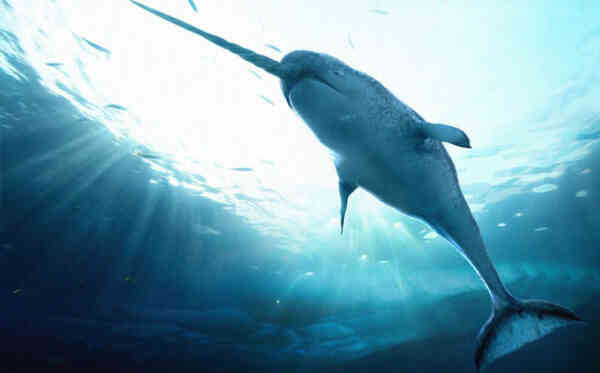These amazing marine unicorns, narwhals, are truly unique animals. No other forms of life on Earth are similar to them, and they themselves have chosen very harsh conditions for their existence. Scientists have been racking their brains for a long time about the quirks of evolution that gave rise to these creatures, and it should be noted that some of these heated debates have not subsided to this day.
Interesting facts about narwhals
- Their name comes from the Icelandic language and means «dead whale». It took root because of the impressive size of narwhals, combined with a very peculiar coloring of the skin (interesting facts about whales).
- Narwhals belong to the cetacean genus, and just like whales, they are descended from terrestrial artiodactyl mammals. Maybe once unicorns really walked the Earth?
- There are only two teeth in the jaw of a narwhal, and one of them, the left one, develops into a tusk. About 2 narwhals out of 1000 have two tusks – this happens if both teeth begin to grow, but this happens very rarely.
- They do not have dorsal fins.
- Male narwhals weigh three times as much females.
- The weight of an adult narwhal can reach 3 tons with a length of up to 4.5 meters. Once there were specimens up to 6 meters long, but this species has been crushed over the past centuries.
- About a third of the total weight of the narwhal falls on fat, the layer of which reaches 10 centimeters in thickness. This is a vital necessity, given that these animals live in very cold waters, and only fat does not allow them to die from hypothermia.
- Narwhal tusk is not just a bone. It is riddled with millions of nerve endings.
- Scientists once filmed a narwhal using its tusk as a club to stun its prey.
- In captivity, these animals quickly wither and die.
- Narwhals are not adapted to life in warm water. They leave the polar waters only in winter, and usually not for long. Sometimes they were even seen off the coast of Great Britain (interesting facts about Great Britain).
- To get out from under the ice and take a breath of air, narwhals break the ice with the help of tusks, and simply hitting it with their backs. Ice at least 5 centimeters thick is quite capable of breaking through them.
- Narwhals communicate with each other using a whole range of sounds, probably having a clear meaning. To us, they seem to be squeaking, whistling, clicking and some kind of gurgling.
- In the Middle Ages, various kinds of charlatans often passed off narwhal horns as unicorn horns (interesting facts about the Middle Ages).
- The largest narwhal tusk it is 3 meters long, but weighs only about 10 kg.
- An angry narwhal can attack and sink a boat. Its tusk is very strong, and it is quite capable of damaging a small vessel.
- The broken tusk of these animals does not grow back.
- In search of prey, narwhals dive to a depth of up to a kilometer.
- They help each other clean the tusks from growths by scratching them.
- Northern peoples like the Eskimos have hunted narwhals for centuries. The rendered fat is filled with lamps, and various figures are cut out of the tusks.
- Narwhals live in the wild for more than 50 years.
- These animals prefer to huddle in small groups of 5-10 individuals, but, in unlike whales and sperm whales, they do not form large herds.
- Polar bears and killer whales successfully hunt narwhals (interesting facts about killer whales).
- The warmer the water, the more oxygen they need for respiration, so that in summer they come up more often to take a breath of air than in winter.
- Polar sharks often prey on baby narwhals. Adults are too tough for them.
- It was once believed that a piece of narwhal horn would change color if thrown into a glass of poisoned drink.
